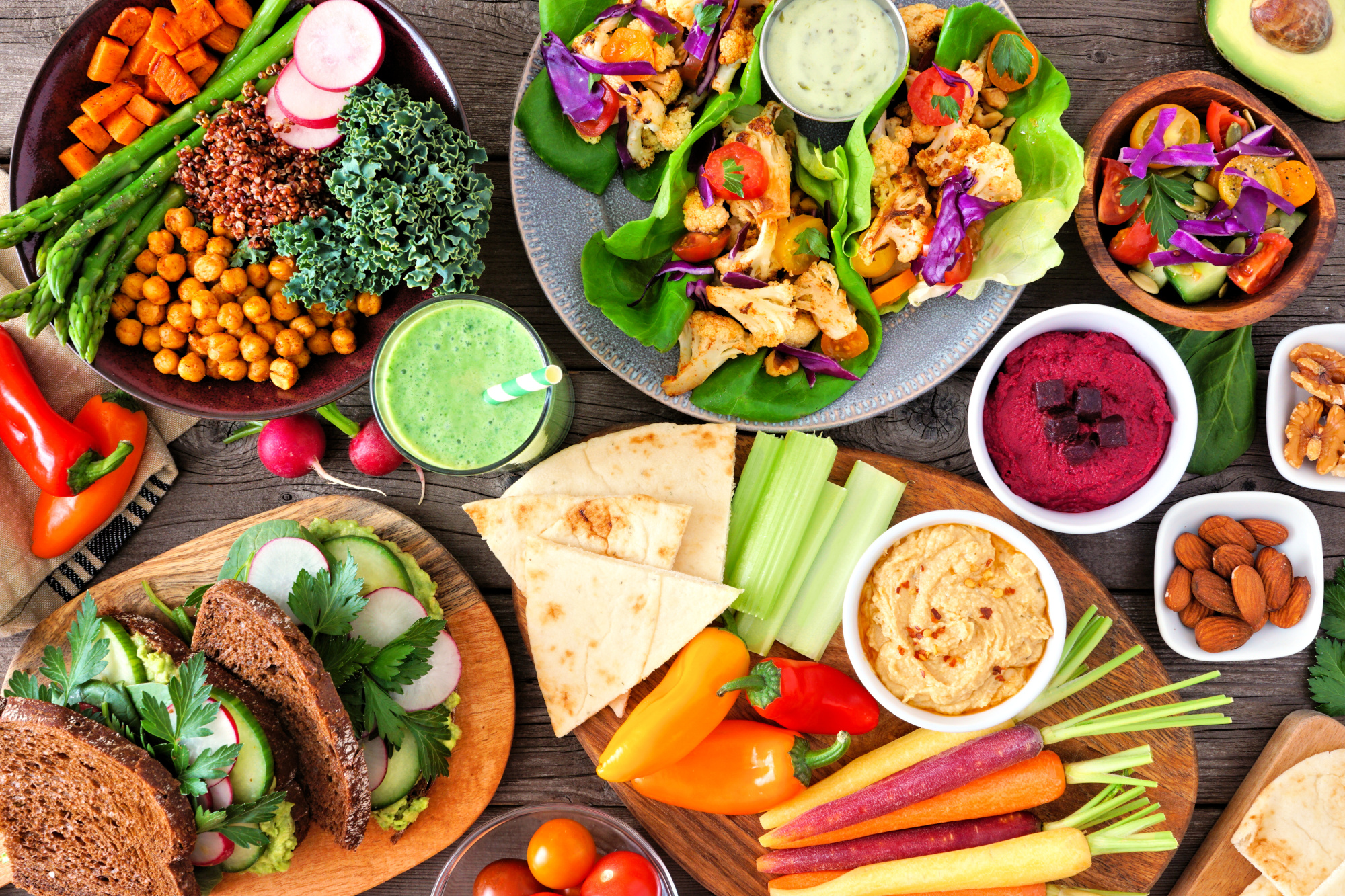There are still a lot of prejudices about vegan and vegetarian lifestyles, including the idea that a plant-based diet does not provide sufficient protein. In this article, ProVeg investigates this claim and shows that plant-based nutrition is perfectly suitable for meeting everyone’s protein requirements.
What are proteins?
Proteins are complex chemical compounds consisting of many individual amino acids. The human body uses 21 amino acids for protein production, of which at least nine, called essential amino acids, cannot be produced by the body itself. A supply of these amino acids via dietary proteins is therefore vital for the maintenance of the body’s own protein structures.1 2
Functions of proteins
The functions of proteins inside the human organism are numerous. Their most important function is the construction of body tissue. Among other things, structural proteins serve as core building blocks for muscle, nerve, and connective tissue. Mass transport within the body, on the other hand, is carried out by transport proteins such as haemoglobin – a constituent of blood. The antibodies of the immune system and the protein fibrinogen, which facilitates blood clotting, belong to the class of protective proteins. Many hormones and enzymes which control important processes in the body are also proteins.3
Protein requirements
According to the committee of the European Food Safety Authority (EFSA), the daily recommended values for the protein intake of mixed foods are as follows: 4 5
- Adults and the elderly: 0.83 g per kilogram of body weight.
- Infants, children and adolescents: depending on their age, between 0.83 g and 1.31 g per kilogram of body weight.
- Pregnant women: 0.83 g per kilogram of body weight and an additional intake of 1 g, 9 g, and 28 g for the first, second, and third trimester of pregnancy, respectively.
- Breastfeeding mothers: 0.83 g per kilogram of body weight and an additional intake of 19 g during the first six months of breastfeeding, 13 g thereafter.
Protein deficiency
Since proteins are involved in the construction, function, and metabolism of all living cells and tissues, a deficiency leads to various disorders of bodily functions. In adults, an insufficient supply of protein can lead to a weakened immune defence, reduced wound healing, and a reduction in muscle mass.6 During childhood, mental impairment can also occur. However, protein deficiency is extremely rare in developed countries, although it is more common in developing countries whose populations are affected by malnutrition.7
Foods rich in protein
Among vegetables, pulses (lentils, peas, and beans – and, above all, soya beans) and cereals (rice, oats, millet, wheat, spelt, rye) are of particular importance as protein sources. Soya products such as tofu and tempeh are also high in protein. Pseudocereals (amaranth, buckwheat, quinoa), nuts, almonds, and seeds also contain especially high amounts of protein.8
Quality of food proteins
The contribution that protein from food makes to human nutrition depends on several factors. In addition to the protein content of the food, the digestibility and amino-acid composition of proteins are also important.9
Biological value of protein
Both animal and vegetable proteins contain all essential amino acids. They differ, however, in terms of the amounts they contain.10 The more the composition of amino acids corresponds to the human organism’s needs, the higher the biological value of a food protein. If the biological value of a protein is higher, less of it needs to be consumed in order to meet protein requirements as it is better suited to be converted into the body’s own protein.11 12 On average, proteins from animal products have a higher biological value than those from vegetable products, with exceptions including, for example, soybeans, potatoes, rice, and rye.13 14 However, the biological value is increased considerably by combining different foods, as their respective amino-acids complement each other. What is important is not the profile of amino-acids in a single meal, but rather the distribution of amino-acid supply across the whole day. If a person consumes enough protein from a wide variety of plant-based protein sources – such as pulses and wholemeal cereals, pulses, nuts, and seeds – as well as enough calories, protein requirements can easily be met with plant foods.15 16
Digestibility of vegetable protein sources
A useful measure of digestibility is the ‘protein digestibility-corrected amino acid score’ (PDCAAS), which takes into account not only the amino acid composition of a protein but also its digestibility. 17) The higher the PDCAAS, the more easily and more completely the protein can be digested and the less protein needs to be consumed in order to cover protein requirements. Proteins of animal origin are usually more digestible than vegetable proteins as dietary fibre and robust cell walls contribute to the reduced digestibility of most vegetable proteins.18 19 However, the digestibility of many plant sources of protein is still relatively good and can be significantly increased by higher processing and proper chewing. The following methods of preparing pulses and cereals, for example, increase their digestibility and thus the absorption of vegetable protein:
- Cooking (cooking time varies depending on the type of pulse/cereal; cooking in a pressure cooker is particularly effective in terms of enhancing digestibility)
- Shredding, for example, in a food processor or blender
- Soaking in water (the soaking time and amount of water varies, depending on the type of pulse/cereal)20
Plant-based sources of protein are healthier than their animal counterpart
The biological value and digestibility of food are almost meaningless when it comes to determining how healthy a particular food is. Vitamins, minerals, dietary fibre, phytochemicals, carbohydrates, and unsaturated fatty acids also play an important role. In this regard, plant protein sources usually have an edge over animal-based proteins, as the latter often contain many unhealthy saturated fatty acids. According to a study published by Harvard Medical School in 2016, an increase in the intake of plant protein was associated with a lower mortality rate, especially cardiovascular mortality. ”Substitution of plant protein for animal protein, especially from processed red meat, may confer a substantial health benefit. Therefore, public health recommendations should focus on improvement of protein sources”, the researchers concluded.21 A systematic review of 32 prospective cohort studies came to the same conclusion.22
Researchers at the University of Massachusetts also recently discovered that the source of protein – whether it is meat, fish, dairy products or pulses – is irrelevant in terms of building muscle strength and muscle mass.23
Protein supply for vegans and vegetarians
Lacto and ovo-lacto vegetarians consume ample amounts of essential amino-acids so long as they consume the recommended amount of protein and calories. Similarly, the US-based Academy of Nutrition and Dietetics has stated that a well-planned vegan diet can meet all dietary recommendations and ensure an adequate protein supply.24 Various nutritional associations from other countries – such as the National Health and Medical Research Council in Australia25 and the Portuguese National Programme for the Promotion of Healthy Eating26 – also share this view. Since vegans usually consume less food energy than omnivores and lacto or ovo-lacto vegetarians, their consumed protein amounts are usually closer to the recommendations of nutritional associations, while the average person in western industrialized countries often exceeds the recommendations.
Although there is a risk of protein deficiency if too few calories are consumed on a vegan diet, protein requirements can certainly be met with a plant-based diet. The consumption of a wide range of plant foods and a sufficient intake of calories are key.
ProVeg tips for optimal plant-based protein supply
- A vegan diet can provide a sufficient supply of protein if a broad selection of vegetable protein and a sufficient intake of calories is ensured.
- Pulses – especially soya products – constitute important sources of protein in a plant-based diet and should be eaten daily. In combination with proteins from cereals and nuts or seeds, they help to provide an optimal amino acid profile. It is sufficient to eat the different sources of protein throughout the day, rather than during a single meal.
- The different methods of preparation (cooking, mixing, soaking) of vegetable foods increase their digestibility and thus the absorption of vegan protein.
- There is an increasing awareness that plant proteins are healthier than animal proteins. The consumption of plant protein instead of animal protein is associated with lower mortality rates.
References
- U.S. Department of Health & Human Services (2020): Amino acids. Available at https://medlineplus.gov/ency/article/002222.htm
- U.S. Department of Health & Human Services (2017): What are proteins and what do they do?, Available at https://medlineplus.gov/genetics/understanding/howgeneswork/protein/ [09.12.2020]
- U.S. Department of Health & Human Services (2017): What are proteins and what do they do?, Available at https://medlineplus.gov/genetics/understanding/howgeneswork/protein/ [09.12.2020]
- European Food Safety Authority (2012): EFSA sets population reference intakes for protein, Available at https://www.efsa.europa.eu/en/press/news/120209 [04.12.2020]
- European Food Safety Authority (2015): Scientific Opinion on Dietary Reference Values for protein. EFSA Panel on Dietetic Products, Nutrition and Allergies (NDA). Available at: https://efsa.onlinelibrary.wiley.com/doi/epdf/10.2903/j.efsa.2012.2557 [11.12.2020]
- Paul Insel, Don Ross, Kimberley McMahon, Melissa Bernstein (2013). Nutrition (5th edition), p 220
- Leitzmann, C. & M. Keller (2013): Vegetarische Ernährung: 74 Tabellen. S. 273
- Daniel, P., Harvard University (2017): How much protein do you need every day? Available at https://www.health.harvard.edu/blog/how-much-protein-do-you-need-every-day-201506188096 [03.03.2018]
- European Commission (2020): Dietary Protein. Available at https://ec.europa.eu/jrc/en/health-knowledge-gateway/promotion-prevention/nutrition/protein [04.12.2020]
- Mangels, R., Messina, V. & Messina, M. (2011). The Dietitian’s Guide to Vegetarian Diets (3rd edition). p. 71
- Hoffman, J. R., & Falvo, M. J. (2004): Protein – Which is Best?. Journal of sports science & medicine, 3(3), 118–130
- Burgenstein U, Schurgast H & Zimmermann M. (2012). Handbuch der Nährstoffe – Vorbeugen und heilen durch ausgewogene Ernährung; 12. Überarbeitete Auflage. Trias: Stuttgart, S. 75
- Henkel J. Soy. Health claims for soy protein, questions about other components. FDA Consum. 2000;34(3):13–15,18–20.
- Mangels, R., Messina, V. & Messina, M. (2011). The Dietitian’s Guide to Vegetarian Diets (3rd edition). p. 71
- Melina, V., W. Craig & S. Levin (2016): Position of the Academy of Nutrition and Dietetics: Vegetarian Diets. Journal of the Academy of Nutrition and Dietetics 116(12), 1970–1980. doi:10.1016/j.jand.2016.09.025
- Hoffman, J. R., & Falvo, M. J. (2004). Protein – Which is Best?. Journal of sports science & medicine, 3(3), 118–130
- Insel, P. et al. (2013). Nutrition (5th edition). Burlington: Jones and Bartlett. S. 243
- Tomé, D. (2013): Digestibility issues of vegetable versus animal proteins: Protein and amino acid requirements – functional aspects. Food and Nutrition Bulletin. 34, p.272–273
- Hoffman, J. R., & Falvo, M. J. (2004). Protein – Which is Best?. Journal of sports science & medicine, 3(3), 118–130
- Mangels, R., Messina, V. & Messina, M. (2011). The Dietitian’s Guide to Vegetarian Diets (3rd edition). S. 69
- Song, M., T. T. Fung, F. B. Hu, et al. (2016): Association of Animal and Plant Protein Intake With All-Cause and Cause-Specific Mortality. JAMA Internal Medicine 176(10), 1453. doi:10.1001/jamainternmed.2016.4182
- Naghshi S, Sadeghi O, Willett WC, Esmaillzadeh A. (2020): Dietary intake of total, animal, and plant proteins and risk of all cause, cardiovascular, and cancer mortality: systematic review and dose-response meta-analysis of prospective cohort studies. BMJ. 2020 Jul 22;370:m2412. doi: 10.1136/bmj.m2412
- University of Massachusetts (2017): Dietary protein is associated with musculoskeletal health independently of dietary pattern: the Framingham Third Generation Study, Available at http://ajcn.nutrition.org/content/early/2017/02/07/ajcn.116.136762.abstract?sid=187de680-e319-4d4d-8179-da6ab0835359 [03.03.2018]
- Melina, V., W. Craig & S. Levin (2016): Position of the Academy of Nutrition and Dietetics: Vegetarian Diets. Journal of the Academy of Nutrition and Dietetics 116(12), 1970–1980. doi:10.1016/j.jand.2016.09.025
- National Health and Medical Research Council (2013) Australian Dietary Guidelines. Canberra: National Health and Medical Research Council.
- National Programme for the Promotion of Healthy Eating, Direção-Geral da Saúde (2015): Guidelines for a healthy vegetarian diet. Lissabon.



